
THE EFFECT OF POLYPROPYLENE FIBERS ON COMPRESSIVE AND SPLIT TENSILE STRENGTH OF LIGHTWEIGHT CONCRETE
Mufti Amir Sultan 1![]()
![]() ,
Abdul Gaus 1
,
Abdul Gaus 1![]() , Muhammad Taufiq Yudasaputra 1
, Muhammad Taufiq Yudasaputra 1![]() , Zulham
Lambado 2
, Zulham
Lambado 2![]() ,
,
Ilman Nofiyanto Hi Bayan 3![]()
1 Department
of Civil Engineering, University of Khairun, Ternate,
Indonesia
2 Student
of the Civil Engineering Master’s Program, University of Khairun,
Ternate, Indonesia
3 Student
of the Civil Engineering Department, University of Khairun,
Ternate, Indonesia
|
|
ABSTRACT |
||
|
This study was
carried out to design lightweight concrete, which is enriched with
polypropylene fibers using coarse pumice and sand fine aggregates.
Lightweight concrete specimens were classified into distinct groups based on
fibers content employed, namely a control group with 0 kg/m³ and the
experimental incorporating 0.1 kg/m³, 0.3 kg/m³, 0.5 kg/m³, and 0.7 kg/m³
varying quantities of polypropylene fibers. Subsequently, after a curing
period of 28 days, the hardened concrete test was conducted on cylinder
specimens measuring 150 mm x 300 mm. The consistency of the fresh concrete
mixture was tested using the Abrams cone test, which revealed a decrease in
the workability of fibers-reinforced concrete with
an increase in fibers volume in the mixture. The test aimed to determine the
effect of polypropylene fibers on compressive and tensile strength of
lightweight concrete. The optimal compressive and split tensile strength was
observed at fibers volume fraction of 0.5, to obtain 7.84 MPa, or 56.68%
increase in compressive strength, and 2.12 MPa or 42.86% rise in tensile
strength. Based on compressive and split tensile strength obtained from this
study, concrete was classified as highly lightweight structural concrete,
which served as an insulator. |
|||
|
Received 10 July
2024 Accepted 12 June 2024 Published 05 August 2024 Corresponding Author Mufti
Amir Sultan, muftiasltn@unkhair.ac.id DOI 10.29121/granthaalayah.v12.i7.2024.5725 Funding: This research
received no specific grant from any funding agency in the public, commercial,
or not-for-profit sectors. Copyright: © 2024 The
Author(s). This work is licensed under a Creative Commons
Attribution 4.0 International License. With the
license CC-BY, authors retain the copyright, allowing anyone to download,
reuse, re-print, modify, distribute, and/or copy their contribution. The work
must be properly attributed to its author.
|
|||
|
Keywords: Lightweight Concrete, Fibers-Reinforced
Concrete, Pumice, Compressive Strength, Spilt Tensile Strength |
|||
1. INTRODUCTION
Based on seismic zoning, a significant portion of
Indonesia is located
within earthquake-prone regions making the
meticulous selection of
building materials a crucial endeavor. This importance arises from the fact that these structures bear
the primary permanent load of a building. The considerable weight of this permanent
load exacerbates the vulnerability of the structure to seismic
forces, increasing the risk of potential collapse. In order to address this issue, opting for
lightweight concrete emerges as a strategic choice. By reducing the overall
weight of the building, the cumulative impact of earthquake-induced loads can
be mitigated, ultimately leading to enhanced safety measures. Moreover,
the benefits of this method extend to the foundation of these structures. The reduced
weight of the building places less stress on the capacity of the foundation to
support vertical loads. Strength of lightweight concrete is generally 25
to 35% lower than that of the conventional
type Bindu et al. (2022) .
Lightweight concrete is commonly described
as having a volume
weight that does not exceed 2000 kg/m3 Kabay & Aköz (2012). However,
this definition
varies across different
regions worldwide. For instance, in the United States, lightweight concrete is
defined by a volume weight range of 1440 to
1840 kg/m3 ACI 318-02. (2014).
In
Japan, the specific volume weight value is not specified, rather, it depends on the use of lightweight aggregates for both
coarse and fine aggregates. Concrete
regulations in Norway states that lightweight type has a maximum compressive strength of 85 MPa, and it is permissible to use any type
of aggregate. This includes a combination of lightweight and natural
aggregates, but the volume weight should not exceed 1200 kg/m3. In Australia,
lightweight concrete is classified based on a volume weight of less than 1800
kg/m3 for its constituent aggregates Clarke (2005). According to ACI 213R guidelines, structural lightweight concrete is
defined as a 28-day concrete with strength of 17 MPa and a density range of
1120 to 1920 kg/m3ACI 213R. (2014). In
Indonesia, lightweight concrete is
characterized by a volume weight of less than 1850 kg/m3.
Pumice, lightweight
and porous volcanic rock, presents an intriguing option for producing
lightweight concrete. This natural
material can potentially reduce the overall weight of concrete while
maintaining satisfactory strength, making it suitable for various construction
applications. The concept involves using pumice as both coarse and fine aggregates in concrete. It
is found in various countries, such as
Japan and New Zealand Liu et al. (2015). In Indonesia, this stone is distributed in
Jambi, Lampung, West Java, Banten, Yogyakarta, West, and East Nusa Tenggara, as well as North
Maluku, specifically on Tidore Island Sultan
et al. (2021).
This distinctive rock is characterized by its light color and high porosity. It is a type of igneous rock
formed from explosive volcanic eruptions. This rock is often referred to as
volcanic glass silicate due to the presence of foam originating from
glass-walled gas bubbles during its formation. Pumice is widely used as lightweight
concrete aggregate and an abrasive material in various industrial products. Its
high porosity allows it to float on water. The rock exhibits high vesicular
properties, containing numerous cells formed from the expansion of the gas foam
trapped within. The abundant pore spaces enclosed by thin,
delicate walls contribute to
its exceptionally low density. Generally, pumice has a density of less than 1,
enabling it to remain afloat on water effortlessly. It is found as fragments or debris within volcanic breccias.
Common minerals found in pumice include feldspar, quartz, tridymite, and
cristobalite Rashad (2019).
Pumice possesses the essential physical characteristics required for functioning as concrete aggregate, offering a compelling option as lightweight alternative. It fulfills the requirements of lightweight concrete and
significantly reduces the structural load, leading to smaller foundation
designs Suseno et al. (2021). Pumice-aggregate concrete is usually used in earthquake-resistant buildings, particularly where thermal resistance is a primary
criterion, as well as in areas prone to acid rain Muralitharan & Ramasamy
(2015). When used as a coarse aggregate, pumice substantially contributes to the
overall reduction in
concrete weight, thereby categorizing
it as lightweight Mushtaq Khan & Sachar (2022). In cases where pumice substitutes for coarse
aggregate, compressive strength is slightly reduced compared to standard concrete. This
necessitates the incorporation of additives to maintain adequate strength
levels. However,
this type of concrete typically exhibits lower volume weight than regular
concrete mixes Idi et al. (2020). The integration
of pumice into concrete formulations involves partial substitution for coarse
aggregate. The
replacement of pumice up to a
threshold of 50% maintains
tensile, compressive, and
flexural strength levels
comparable to conventional concrete. Once the replacement surpasses 50%, its strength experiences
a gradual decline. As a result, replacing 50% of aggregate with pumice
proves effective for structural purposes, while the 60% to 100% replacement
range is only suitable for non-structural applications. It was concluded that due to its concrete-like
properties, pumice can effectively serve as lightweight aggregate. The outcome also meets the specified criteria for lightweight
concrete production Numan et al. (2021). Lightweight concrete with
varying strength grades and unit weights can be produced by combining pumice aggregate with an air-entraining agent admixture. This type of concrete
falls short of meeting strength requirements for load-bearing structural elements Manzoor et al. (2018). The use of 100% pumice coarse aggregate
tends to decrease compressive and flexural strength of reinforced concrete
beams Sultan
et al. (2021).
In order to address this issue, it is imperative to explore innovative solutions, such as the incorporation of fibers into concrete mixture. Numerous studies have been
conducted to enhance concrete properties, particularly its toughness. The use
of fibers has been proven to enhance the
mechanical properties and durability of concrete. Many studies have been conducted to investigate the performance and advantages of fibers-reinforced
concrete in recent decades Annamaneni & Pedarla
(2023), Biradar et al. (2020), Geremew et al. (2021), Gupt & Dulawat
(2020), Khan & Ali (2019), Nkomo et al. (2022), Wang et al. (2023), Zhang & Li (2013). Furthermore, steel, glass, polyethylene, polypropylene, polyvinyl alcohol,
polyester, basalt, and natural fibers, are commonly used in concrete materials. These fibers serve three main benefits in concrete
compositions, namely reducing cracking, providing reinforcement, and enhancing toughness.
2. MATERIAL AND METHOD
This
study was based on an experimental method and involved the use of several
materials. Portland Type 1 cement and water were used as the binding and mixing
materials. The composition also included pumice sand fine and coarse aggregates.
In addition, polypropylene fibers were introduced as
an additional component in the mixture.
2.1. AGGREGATES
Pumice
sand fine and coarse aggregates were sourced from the Goto quarry in North
Maluku. The gradation of the fine aggregate in Zone I. Meanwhile, pumice coarse
aggregate in Zone I (max 40 mm). The visual representation of the texture of
both aggregates is shown in Figure 1.
2.2. Polypropylene fibers
Polypropylene
fibers possess water-repellent properties and are
resistant to alkali, chemicals, and chlorides. In this study, polypropylene fibers were cut to a length of 12 mm. The amount of fibers used was based on
volume fraction for concrete mixture, namely 0.1 kg/m3, 0.3 kg/ m3,
0.5 kg/ m3, and 0.7 kg/ m3. In contrast, the control
specimens were prepared without the use of polypropylene fibers
(0%). Figure 2 shows the visual
representation of polypropylene fibers used in this
study.
Figure 1

|
Figure 1 The Texture of Fine Aggregate and Coarse Aggregate |
Figure 2
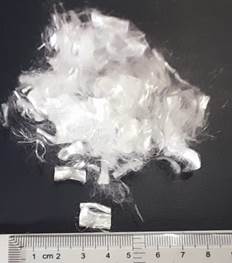
|
Figure 2 Polypropylene Fibers Used in this Study |
2.3. SPECIMENS
Cylinderical-shaped concrete specimens
were used for the assessment of compressive and split tensile strength. These
cylinders were characterized by a diameter and height of 150 mm and 300
cm. The testing took place once the specimens
reached 28 days of curing, with a total of 90 samples involved in the analysis.
3. RESULTS AND ANALYSIS
3.1. Slump test
The
slump value of fresh concrete was examined to ensure the required workability.
In this study, the planned slump value falls within the range of 60 to 80 mm.
The slump value of concrete without fibers was
approximately 75 mm, whereas that of the first fibers-reinforced
concrete mixture decreased from 65 mm at a volume fraction of 0.1 to 20 mm at a
volume fraction of 0.7, as shown in Figure 3.
Figure 3
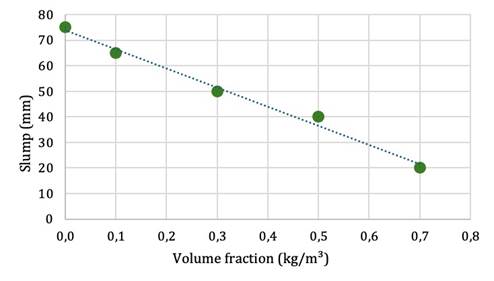
|
Figure 3 Concrete Slump to Polypropylene Fibers Volume Fraction |
Figure 3 shows that an increase in fibers
volume fraction within fibers-reinforced concrete
mixture requires more water. The decrease in fibers-reinforced
concrete workability with an increased volume fraction of polypropylene fibers in the mixture is due to the significant frictional
resistance generated between polypropylene fibers and
concrete particles Hasan et al. (2019).
3.2. Volume weight of fibers-reinforced concrete
The volume weight of polypropylene fibers-reinforced
concrete after 28 days of curing is shown in Figure 4. Lightweight concrete
without polypropylene fibers exhibits the highest
density value of 1505
kg/m3. Meanwhile, concrete with polypropylene fibers
has the lowest value, recorded
at 1129 kg/m3, thereby classifying it as lightweight concrete.
Figure 4
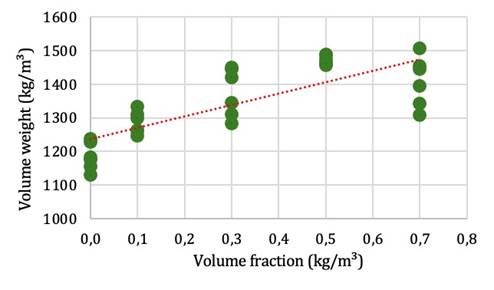
|
Figure 4 The Volume Weight of Polypropylene Fibers-Reinforced Concrete |
3.3. The effect of polypropylene fibers on compressive strength
Figure 5 shows that
polypropylene fibers tend to affect concrete mixture by enhancing the 28-day
compressive strength. The maximum compressive strength of 7.84 MPa was achieved at a volume
fraction of 0.5, accounting for 56.68% of strength observed in concrete
without fibers. Strength starts
to decrease as fibers concentration increases further
because higher fibers volume disrupts the compactness
of concrete matrix. Based on the test results, the produced concrete falls into
the highly lightweight structural concrete category, serving as an insulator Gaus et al. (2022).
Figure 5
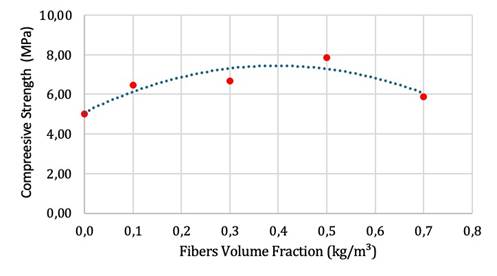
|
Figure 5 Compressive Strength of Polypropylene Fibers-Reinforced Concrete |
3.4. The effect of polypropylene fibers on split tensile strength
According
to Figure 6, tensile strength starts to increase as fibers volume
fraction rises. It reaches a maximum value of 2.12 MPa at fibers volume
fraction of 0.5, which is 42.86% higher than tensile strength of fibers-less
concrete. The increase in split tensile strength occurred due to two factors, namely the even distribution of fibers within the mixture and the careful selection of fibers proportions. Tensile strength improves primarily
because of the bonding mechanism of polypropylene fibers.
However, the addition of fibers volume fraction greater than 0.5 leads to a reduction in the bond
strength between concrete components, resulting in earlier failure compared to
concrete with a lower fibers volume Ahmed et al. (2006).
Figure 6
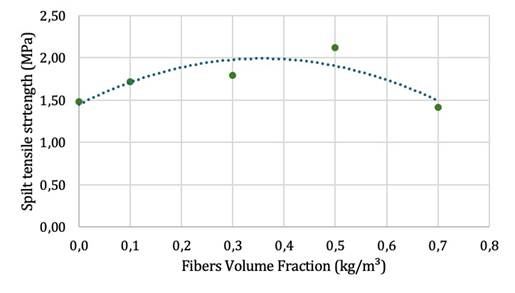
|
Figure 6 Split Tensile Strength of Polypropylene Fibers-Reinforced Concrete |
3.5. Relationship between compressive and split tensile strength
A suitable method for calculating tensile strength of normal concrete, fct, is 0.10f’c < f’ct < 0.2f’c Nawy (2005). Based on Table 1 and Figure 7, the obtained split tensile strength values from the calculations do not align with the theoretical ranges. For instance, tensile strength of normal concrete without fibers is 1.49 MPa, surpassing the projected range of 0.50 to 1.00 MPa. Split tensile strength of concrete with the addition of polypropylene fibers at a volume fraction of 0.1 is 1.72 MPa, exceeding the range of 0.65 to 1.29 MPa. Furthermore, split tensile strength of concrete with the addition of polypropylene fibers at a volume fraction of 0.3 is 1.79 MPa, surpassing the expected range of 0.67 to 1.33 MPa. This trend persists as concrete containing polypropylene fibers at a volume fraction of 0.5 showed split tensile strength of 2.12 MPa, which is above the projected range of 0.78 to 1.57 MPa. Meanwhile, split tensile strength of concrete with the addition of polypropylene fibers at a volume fraction of 0.7 is 1.41 MPa, exceeding the range of 0.59 to 1.18 MPa. The addition of polypropylene fibers to lightweight concrete results in a decrease in compressive strength, albeit not significantly. Split tensile strength of lightweight concrete increases due to the addition of polypropylene fibers. The measured values for each variant surpass the theoretical tensile strength of normal concrete.
Table 1
|
Table 1 Relationship Between Compressive and Tensile Strength in Concrete |
||||
|
Fibers Fraction (kg/m3) |
Compressive Strength (MPa) |
Spilt Tensile Strength (MPa) |
Tensile Strength (MPa) |
|
|
|
|
|
0.1fct |
0.2fct |
|
0.0 |
5.00 |
1.49 |
0.50 |
1.00 |
|
0.1 |
6.47 |
1.72 |
0.65 |
1.29 |
|
0.3 |
6.67 |
1.79 |
0.67 |
1.33 |
|
0.5 |
7.84 |
2.12 |
0.78 |
1.57 |
|
0.7 |
5.88 |
1.41 |
0.59 |
1.18 |
Figure 7
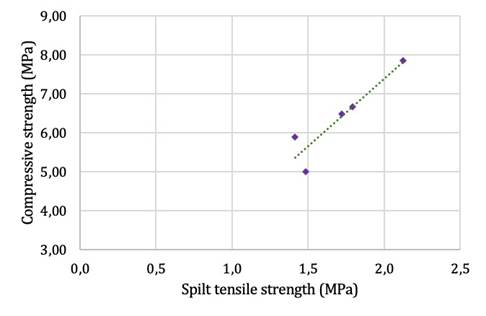
|
Figure 7 Graph of the Relationship Between Compressive and Split Tensile Strength |
4. RESULTS AND ANALYSIS
In conclusion, the analysis of the experimental results and data showed that the volume weight of the obtained concrete ranged between 1129 kg/m3 and 1505 kg/m3. Therefore, it was classified as lightweight concrete. The workability of lightweight concrete decreased as the volume fraction of polypropylene fibers in the mixture increased. The optimal compressive and split tensile strength of lightweight concrete occurred at a volume fraction of 0.5 kg/m3, with values of 7.84 MPa and 2.12 MPa, respectively. These values represented an increase of 56.68% and 42.86% compared to compressive and split tensile strength of fibers-less concrete. The relationship between compressive and split tensile strength of polypropylene fibers-reinforced lightweight concrete exceeded that of the normal type.
CONFLICT OF INTERESTS
None.
ACKNOWLEDGMENTS
The authors are grateful to the Research and Community Service Institute of Khairun University for funding this study through the Higher Education Superior Competitive Research (PKUPT) Grant for the Graduate Program level in 2023.
REFERENCES
ACI 213R. (2014). Guide for Structural Lightweight Agregate Concrete. In ACI Committee Report. https://doi.org/10.14359/7576
ACI 318-02. (2014). Building Code Requirements For Structural Concrete.
Ahmed, S., Bukhari, I. A., Siddiqui, J. I., & Qureshi, S. A. (2006). A Study on Properties of Polypropylene Fiber Reinforced Concrete. 31st Conference on Our World in Concrete and Structures, 1–10.
Annamaneni, K. K., & Pedarla, K. (2023). Compressive and Flexural Behavior of Glass Fiber-Reinforced Concrete. Journal of Physics: Conference Series, 2423(1), 1–9. https://doi.org/10.1088/1742-6596/2423/1/012025
Bindu, H. M., Geethika, P., Kumari, P. B., & Kumar, M. A. (2022). A Review on Lightweight Aggregate Concrete. Journal of Architecture and Civil Engineering, 7(11), 34–41.
Biradar, S. V, Dileep, M. S., & Gowri, V. T. (2020). Studies of Concrete Mechanical Properties with Basalt Fibers. IOP Conference Series: Materials Science and Engineering, 1006(1), 1–8. https://doi.org/10.1088/1757-899X/1006/1/012031
Clarke, J. L. (2005). Structural Lightweight Aggregate Concrete (J. L. Clarke, Ed., First). Blackie Academic & Prefessional.
Gaus, A., Sultan, M. A., Hakim, R., & Rauf, I. (2022). Effects of Using Pumice Sand as A Partial Replacement of Fine Aggregate in Lightweight Concrete Mixtures. International Journal of Entrepreneurship and Business Development, 5(4), 660–666. https://doi.org/10.29138/ijebd.v5i4.1882
Geremew, A., Winne, P. De, Demissie, T. A., & Backer, H. De. (2021). Treatment of Natural Fiber for Application in Concrete Pavement. Advances in Civil Engineering, 2021, 1–13. https://doi.org/10.1155/2021/6667965
Gupt, R., & Dulawat, S. (2020). Effect of Polypropylene Fiber for Cement Concrete Based on Rigid Pavement. Journal of Xidian University, 14(4), 2339–2346. https://doi.org/10.37896/jxu14.4/259
Hasan, A. H., Maroof, N. R., & Ibrahim, Y. A. (2019). Effects of Polypropylene Fiber Content on Strength and Workability Properties of Concrete. Polytechnic Journal, 9(1), 7–12. https://doi.org/10.25156/ptj.v9n1y2019.pp7-12
Idi, M. A., Abdulazeez, A. S., Usman, S. A., & Justin, T. (2020). Strength Properties of Concrete Using Pumice Aggregate As Partial Replacement of Coarse Aggregate. International Journal of Engineering Applied Sciences and Technology, 04(11), 519–525. https://doi.org/10.33564/ijeast.2020.v04i11.092
Kabay, N., & Aköz, F. (2012). Effect of Prewetting Methods on Some Fresh and Hardened Properties of Concrete with Pumice Aggregate. Cement and Concrete Composites, 34(4), 503–507. https://doi.org/10.1016/j.cemconcomp.2011.11.022
Khan, M., & Ali, M. (2019). Improvement in Concrete Behavior with Fly Ash, Silica-Fume and Coconut Fibres. Construction and Building Materials, 203, 174–187. https://doi.org/10.1016/j.conbuildmat.2019.01.103
Liu, L., Orense, R. P., & Pender, M. J. (2015). Crushing-Induced Liquefaction Characteristics of Pumice Sand. 2015 NZSEE Conference, 522–528.
Manzoor, M. M., Gupta, A., Gani, R., & Tanta, A. (2018). Floating Concrete by Using Light Weight Aggregates (Pumice Stones) and Air Entraining Agent. International Journal of Scientific Development and Research, 3(6), 99–104.
Muralitharan, R. S., & Ramasamy, V. (2015). Basic Properties of Pumice Aggregate. International Journal of Earth Sciences and Engineering, 8(4), 1845–1852.
Mushtaq Khan, M., & Sachar, A. (2022). Experimental Study on Light Weight Concrete by Partial Replacement of Cement by Flyash, Coarse Aggregate Pumice Stone and Thermocol Beads. International Journal of Innovative Research in Computer Science & Technology, 10(3), 114–119. https://doi.org/10.55524/ijircst.2022.10.3.19
Nawy, E. G. (2005). Reinforced Concrete: A Fundamental Approach (W. J. Hall, Ed.; 5th Ed., Vol. 5).
Nkomo, N. Z., Masu, L. M., & Nziu, P. K. (2022). Effects of Polyethylene Terephthalate Fibre Reinforcement on Mechanical Properties of Concrete. Advances in Materials Science and Engineering, 2022, 1–9. https://doi.org/10.1155/2022/4899298
Numan, N., Gaus, A., & Sultan, M. A. (2021). Comparison of Compressive Strength Value of Concrete Using Pumice Sand with Ordinary Sand as Fine Aggregate. E3S Web of Conferences, 328, 1–4. https://doi.org/10.1051/e3sconf/202132810017
Rashad, A. M. (2019). A Short Manual on Natural Pumice as a Lightweight Aggregate. Journal of Building Engineering, 25, 1–10. https://doi.org/10.1016/j.jobe.2019.100802
Sultan, M. A., Gaus, A., Hakim, R., & Imran, I. (2021). Review of the Flexural Strength of Lightweight Concrete Beam Using Pumice Stone as of Substitution. International Journal of GEOMATE, 21(85), 154–159.
Sultan, M. A., Kusnadi, K., & Adingku, J. (2022). Determination of Geopolymer Mortar Characterization Using Fly Ash and Pumice Sand. International Journal of GEOMATE, 23(100). https://doi.org/10.21660/2022.100.3630
Suseno, H., Wijaya, M. N., & Firdausy, A. I. (2021). Correlation Between Destructive and Non-destructive Characteristics of Pumice and Scoria Lightweight Concretes. Engineering Journal, 25(8), 113–126. https://doi.org/10.4186/ej.2021.25.8.113
Wang, J., Li, M., Chen, J., Zhao, Z., Zhao, H., Zhang, L., & Ren, J. (2023). Investigation on Shrinkage Characteristics of Polyester-Fiber-Reinforced Cement-Stabilized Concrete Considering Fiber Length and Content. Buildings, 13(4), 1–15. https://doi.org/10.3390/buildings13041027
Zhang, P., & Li, Q. F. (2013). Effect Of Polypropylene Fiber On Durability Of Concrete Composite Containing Fly Ash And Silica Fume. Composites Part B: Engineering, 45(1), 1587–1594. https://doi.org/10.1016/j.compositesb.2012.10.006
 This work is licensed under a: Creative Commons Attribution 4.0 International License
This work is licensed under a: Creative Commons Attribution 4.0 International License
© Granthaalayah 2014-2024. All Rights Reserved.